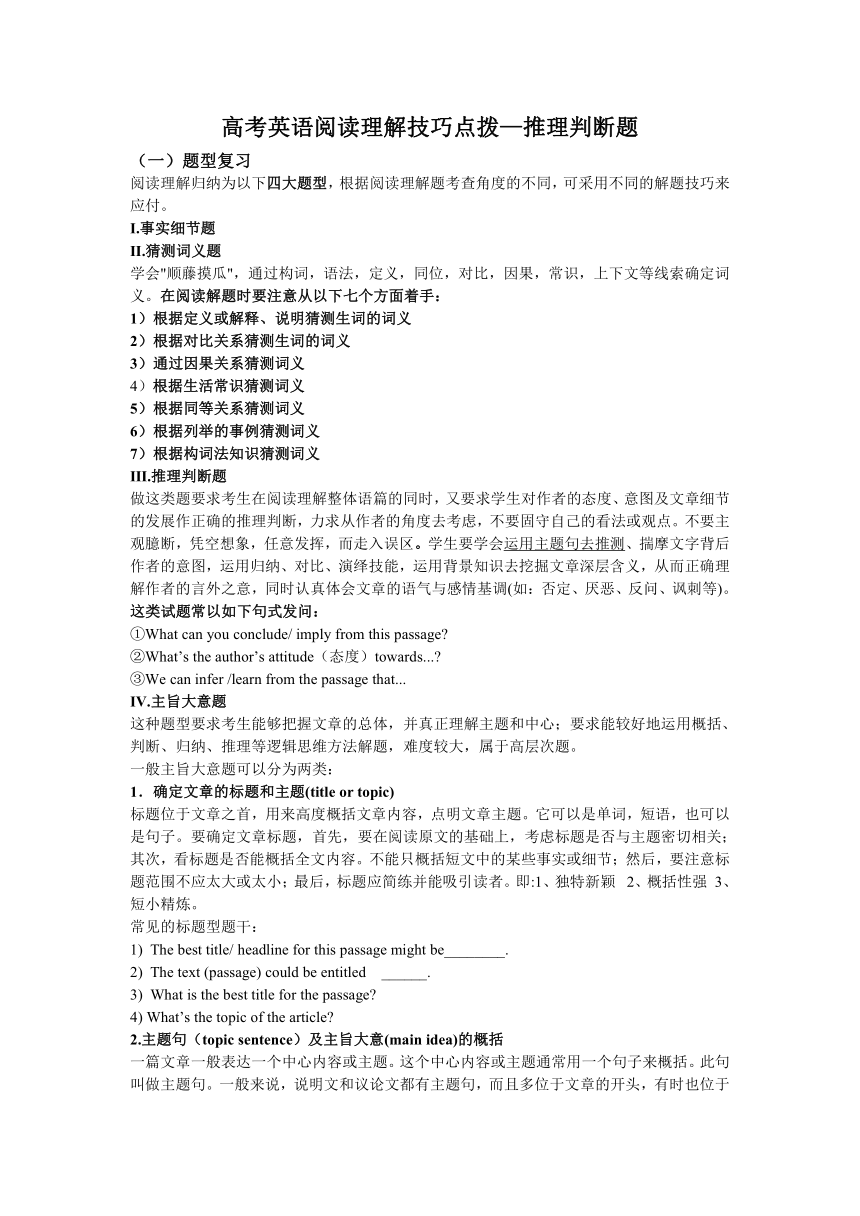高考英语阅读理解技巧点拨—推理判断题
图片预览

文档简介
高考英语阅读理解技巧点拨—推理判断题
(一)题型复习
阅读理解归纳为以下四大题型,根据阅读理解题考查角度的不同,可采用不同的解题技巧来应付。
Ⅰ.事实细节题
Ⅱ.猜测词义题
学会"顺藤摸瓜",通过构词,语法,定义,同位,对比,因果,常识,上下文等线索确定词义。在阅读解题时要注意从以下七个方面着手:
1)根据定义或解释、说明猜测生词的词义
2)根据对比关系猜测生词的词义
3)通过因果关系猜测词义
根据生活常识猜测词义
5)根据同等关系猜测词义
6)根据列举的事例猜测词义
7)根据构词法知识猜测词义
Ⅲ.推理判断题
做这类题要求考生在阅读理解整体语篇的同时,又要求学生对作者的态度、意图及文章细节的发展作正确的推理判断,力求从作者的角度去考虑,不要固守自己的看法或观点。不要主观臆断,凭空想象,任意发挥,而走入误区。学生要学会运用主题句去推测、揣摩文字背后作者的意图,运用归纳、对比、演绎技能,运用背景知识去挖掘文章深层含义,从而正确理解作者的言外之意,同时认真体会文章的语气与感情基调(如:否定、厌恶、反问、讽刺等)。这类试题常以如下句式发问: ①What can you conclude/ imply from this passage? ②What’s the author’s attitude(态度)towards...?
③We can infer /learn from the passage that...
Ⅳ.主旨大意题
这种题型要求考生能够把握文章的总体,并真正理解主题和中心;要求能较好地运用概括、判断、归纳、推理等逻辑思维方法解题,难度较大,属于高层次题。
一般主旨大意题可以分为两类:
1.确定文章的标题和主题(title or topic)
标题位于文章之首,用来高度概括文章内容,点明文章主题。它可以是单词,短语,也可以是句子。要确定文章标题,首先,要在阅读原文的基础上,考虑标题是否与主题密切相关;其次,看标题是否能概括全文内容。不能只概括短文中的某些事实或细节;然后,要注意标题范围不应太大或太小;最后,标题应简练并能吸引读者。即:1、独特新颖? 2、概括性强 3、短小精炼。
常见的标题型题干:
1)??The best title/ headline for this passage might be________.
2)??The text (passage) could be entitled ??______.
3)??What is the best title for the passage?
4) What’s the topic of the article?
2.主题句(topic sentence)及主旨大意(main idea)的概括
一篇文章一般表达一个中心内容或主题。这个中心内容或主题通常用一个句子来概括。此句叫做主题句。一般来说,说明文和议论文都有主题句,而且多位于文章的开头,有时也位于文章的中间或末尾。但有时不能在文中直接找到主题句,要求读者把握每段的主题句,弄清段于段之间逻辑关系的基础上自己归纳总结。主题句必须能简洁明了地概括全文的主要内容,具有高度的综合性和概括性。文章或段落的其他句子都是对主题句的进一步解释,说明,论证或扩展.
常见的主题句和主旨型题干:
1) What is the topic sentence of the passage?
2)?This article/text/passage mainly tells that _____________.
3) Which of the following gives a general idea of the passage?
4) Which of the following is the main idea of the passage?
阅读推理判断题分类:
1. 推断隐含意义
It can be inferred from the text that________________________.
The story indicates that______________________.
标志性词语:infer, indicate, suggest, imply, conclude...
2. 推断作者观点或态度
What does the author think of __________________?
What's the author's attitude toward_______________________?
In the author's opinion, _________________________.
标志性词语:according to the writer, attitude, think, opinion, consider...
3. 推断写作目的
What is the author's main purpose in this passage?
In the passage the author wants to tell__________________________.
The article is intended to ____________________________________________.
标志性词语:purpose, intend to, show, want ...
4. 推断文章出处
Where would this passage most probably appear?
The passage is most likely a part of ______________.
标志性词语:be taken from, appear, a part of, be taken out of ...
5. 推断人物的观点、情感、品性
Sb think that _________________.
What do we know/learn about sb in the text?
How did …feel about…?
标志性词语:attitude, learn form, know from, feel about ...
6. 推断读者对象或文章的作者
Who probably wrote the letter?
Who is the passage written for?
Who are the intended readers of the passage?
标志性词语:the intended reader, writer, author…
7. 推断作者的情感
How does the author feel about_______________?
The writer probably feels that______________________.
标志性词语:feel, feel about...
(一)题型复习
阅读理解归纳为以下四大题型,根据阅读理解题考查角度的不同,可采用不同的解题技巧来应付。
Ⅰ.事实细节题
Ⅱ.猜测词义题
学会"顺藤摸瓜",通过构词,语法,定义,同位,对比,因果,常识,上下文等线索确定词义。在阅读解题时要注意从以下七个方面着手:
1)根据定义或解释、说明猜测生词的词义
2)根据对比关系猜测生词的词义
3)通过因果关系猜测词义
根据生活常识猜测词义
5)根据同等关系猜测词义
6)根据列举的事例猜测词义
7)根据构词法知识猜测词义
Ⅲ.推理判断题
做这类题要求考生在阅读理解整体语篇的同时,又要求学生对作者的态度、意图及文章细节的发展作正确的推理判断,力求从作者的角度去考虑,不要固守自己的看法或观点。不要主观臆断,凭空想象,任意发挥,而走入误区。学生要学会运用主题句去推测、揣摩文字背后作者的意图,运用归纳、对比、演绎技能,运用背景知识去挖掘文章深层含义,从而正确理解作者的言外之意,同时认真体会文章的语气与感情基调(如:否定、厌恶、反问、讽刺等)。这类试题常以如下句式发问: ①What can you conclude/ imply from this passage? ②What’s the author’s attitude(态度)towards...?
③We can infer /learn from the passage that...
Ⅳ.主旨大意题
这种题型要求考生能够把握文章的总体,并真正理解主题和中心;要求能较好地运用概括、判断、归纳、推理等逻辑思维方法解题,难度较大,属于高层次题。
一般主旨大意题可以分为两类:
1.确定文章的标题和主题(title or topic)
标题位于文章之首,用来高度概括文章内容,点明文章主题。它可以是单词,短语,也可以是句子。要确定文章标题,首先,要在阅读原文的基础上,考虑标题是否与主题密切相关;其次,看标题是否能概括全文内容。不能只概括短文中的某些事实或细节;然后,要注意标题范围不应太大或太小;最后,标题应简练并能吸引读者。即:1、独特新颖? 2、概括性强 3、短小精炼。
常见的标题型题干:
1)??The best title/ headline for this passage might be________.
2)??The text (passage) could be entitled ??______.
3)??What is the best title for the passage?
4) What’s the topic of the article?
2.主题句(topic sentence)及主旨大意(main idea)的概括
一篇文章一般表达一个中心内容或主题。这个中心内容或主题通常用一个句子来概括。此句叫做主题句。一般来说,说明文和议论文都有主题句,而且多位于文章的开头,有时也位于文章的中间或末尾。但有时不能在文中直接找到主题句,要求读者把握每段的主题句,弄清段于段之间逻辑关系的基础上自己归纳总结。主题句必须能简洁明了地概括全文的主要内容,具有高度的综合性和概括性。文章或段落的其他句子都是对主题句的进一步解释,说明,论证或扩展.
常见的主题句和主旨型题干:
1) What is the topic sentence of the passage?
2)?This article/text/passage mainly tells that _____________.
3) Which of the following gives a general idea of the passage?
4) Which of the following is the main idea of the passage?
阅读推理判断题分类:
1. 推断隐含意义
It can be inferred from the text that________________________.
The story indicates that______________________.
标志性词语:infer, indicate, suggest, imply, conclude...
2. 推断作者观点或态度
What does the author think of __________________?
What's the author's attitude toward_______________________?
In the author's opinion, _________________________.
标志性词语:according to the writer, attitude, think, opinion, consider...
3. 推断写作目的
What is the author's main purpose in this passage?
In the passage the author wants to tell__________________________.
The article is intended to ____________________________________________.
标志性词语:purpose, intend to, show, want ...
4. 推断文章出处
Where would this passage most probably appear?
The passage is most likely a part of ______________.
标志性词语:be taken from, appear, a part of, be taken out of ...
5. 推断人物的观点、情感、品性
Sb think that _________________.
What do we know/learn about sb in the text?
How did …feel about…?
标志性词语:attitude, learn form, know from, feel about ...
6. 推断读者对象或文章的作者
Who probably wrote the letter?
Who is the passage written for?
Who are the intended readers of the passage?
标志性词语:the intended reader, writer, author…
7. 推断作者的情感
How does the author feel about_______________?
The writer probably feels that______________________.
标志性词语:feel, feel about...
